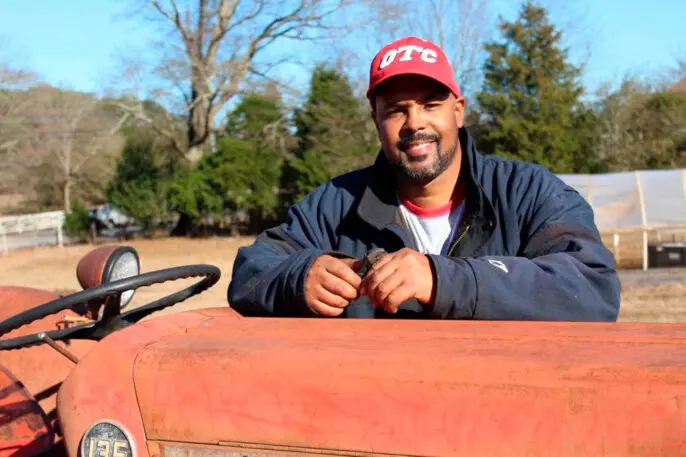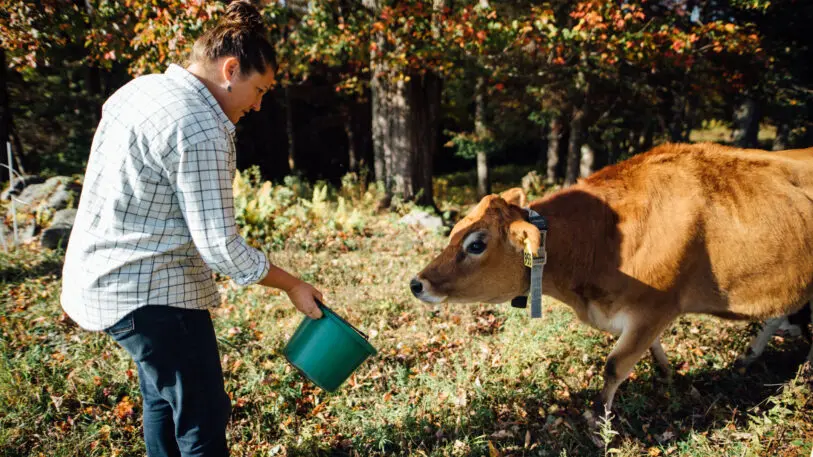Wayne Swanson, who owns a 32-acre family farm in Henry County, Georgia, is trying to persuade his fellow farmers to rethink long-held beliefs about their trade. “We’ve been trained since kids [to think] that farms were places with big, huge silos, and 1,000 acres,” Swanson says. But his philosophy is that less is more: The less farmers disturb the soil, the more produce they’ll get from it. The fewer synthetic chemicals they spray, the more nutritious the food. The less money spent, the more money made. And it’s all accomplishable on smaller plots of land.
He travels to other farms to convert them to his credo. “I’m Captain Obvious because I’m telling you stuff that you probably have already known,” he tells other farmers. “You just never practiced it. You didn’t think that it could be done.”

Swanson Family Farms is one of at least 14 family farms on the steering committee of Regenerate America, a coalition of thousands of independent farmers and ranchers; experts; companies, such as Applegate, Ben & Jerry’s, Timberland, The North Face, and Dr. Bronner’s; and agricultural associations from the Farm & Ranch Freedom Alliance to Earthjustice. All hope to revive regenerative farming in the face of growing land shortages, water pollution, climate change, biodiversity loss—and farmer debt. The campaign is advocating for the practice to be generously funded by the next Farm Bill, Congress’s $1 trillion budget for the farming industry that’s renegotiated every five years, and which provides funding across 12 areas, including nutrition, conservation, crop insurance, and rural development.

“The Farm Bill is one of those bills that, like it or not, is going to get passed,” says Makepeace, also the coalition’s policy director and lead educator. “And it dictates most of our food system.” This time around, the coalition wants the everyday farmers to dictate the policy based on their needs—and not large-scale agribusiness, “who are really always getting the floor when Farm Bills are finalized,” he adds.
Though not suggesting specific dollar investments, the group is emphasizing six priority areas for the Farm Bill, including asks for Congress to expand regenerative education to both farmers and technical service providers, the public employees tasked with helping to train farmers; improve access to markets for local regenerative farmers; and ensure economic opportunities for the historically underserved, including Black and Indigenous farmers, with the help of the National Black Farmers Association. Many of these farmers’ ancestors practiced regenerative farming but were stripped of their land by racist governmental policies. “The history of this is so disgusting,” Makepeace says. “It’s been intentional discrimination and push-outs.”
Currently, 75% of Farm Bill spending goes to nutrition programs, the biggest being the Supplemental Nutrition Assistance Program (SNAP), which helps feed 42 million people in America, and another recommendation is to maintain recent increases to its funding, and to support local and small-scale producers in provisions for federal nutrition programs, to make meals healthier for all. Many of these policies would be sharp changes from decades in which the omnibus bill’s policies have favored large-scale agribusinesses over family farmers; the last one, in 2018, also cut spending for federal environmental and conservation programs.

But in order to influence lawmakers, especially across the aisle, the most crucial message is that regenerative farming is economically viable—in fact, more profitable than its conventional counterpart. Currently, farmer debt rises by 4% every year; the campaign estimates that regenerative farming could reduce input costs for all farmers and ranchers by 25% by 2025. (The 2021 study noted that, though yields were unaffected or lower than with conventional methods, profits were higher.) Regenerative agriculture does require some significant startup costs, mainly for equipment; it could require new tools, such as no-till drills, to plant seeds without tossing up the soil. Some farmers share these with each other, and others get help from outside groups, but more support is needed. “Equipment for advancing the adoption of regenerative practices is not nearly sufficient in the U.S.,” Makepeace says.
But, once things are running, the day-to-day costs become cheaper and cheaper because they completely eliminate the costs of synthetic inputs, a huge and rising cost, which 40% of farmers struggle to afford. On his 7,000-acre row crops, Rick Clark, a fifth-generation farmer in Warren County, Indiana, is saving $171 to $240 per acre on his soy crop, and $430 to $570 per acre on corn. For every 1,000 acres of corn he plants, he saves an average of $500,000—without a sacrifice of yields.

He’s also been teaching a farmer in southern Georgia to repurpose an overgrown field by using sheep as “employees” to graze and clear it, which keeps them fit and healthy. By integrating animals into the systems instead of keeping them in feedlots, they’re handling pests and fertilizing the fields naturally. Swanson recommended a seven-day cycle of rotational grazing, after which the sheep move onto the next paddock. (The sheep now know the schedule, Swanson says. “Tuesday morning, it’s time for us to move up to this next paddock, and they start talking to him.”) Crucially, the farmer is getting better yields with less spending, creating a bigger budget for other (non-baaing) employees. “And, believe it or not, his blood pressure’s going down,” Swanson says, “because every morning he comes out, and he talks to the sheep.”
The coalition also wanted known brands to play a big part in the legislative push in favor of regenerative methods, but it handpicked ones that have demonstrated impact. Regenerative farming has become increasingly important for a company like Applegate, whose business is meat; it makes for a better, more nutrient-packed product, especially at a time of increased calls for less meat intake to curb climate change. “We think this is a great story for a meat company to be telling,” says Gina Asoudegan, Applegate’s VP of mission and innovation.
Applegate is sourcing some of its meat from farms, such as SunFed Ranch, 1.5 million acres of regenerative land, mostly in California. SunFed is the source for Applegate’s first fully regenerative product: the Do Good Dog, available in more than 1,000 Walmarts. They consciously chose the iconic American hotdog, to show that regenerative methods can work for the masses, and not just for upmarket eateries and farmers markets. An independent study estimated that the hotdog is contributing to the regeneration of more than 260,000 acres of U.S. grasslands. At the same time, Applegate is partnering with another company from the coalition, Timberland, which is using the hides from the same cows for its boots.
The coalition has also recently started talking to policymakers, including USDA Secretary Tom Vilsack and House Agriculture Committee Chairman David Scott. In the next 18 months leading up to the bill’s passage, the campaign will be zooming into key districts, getting local constituents’ support. They’ll be holding farm tours, inviting politicians onto the farms to learn in detail how everything works—not just to “take a quick gander and make a stump speech and get on,” Makepeace says, as is the norm during election cycles. Farm tours have so far been the “aha” moment for a lot of lawmakers, he adds. In August 2021, Kiss the Ground organized a tour for Rep. Randy Feenstra of Iowa to the farm of Howard Vlieger, an Iowan third-generation regenerative family farmer, led by soil scientist Ray Archuleta. Makepeace says the Republican representative learned the importance of soil cover, and was admittedly impressed.
To their pleasant surprise, the campaign has been a bipartisan effort. Members of the coalition, from academics to ranchers, are politically diverse, but working together. “People are pushing some hard agendas, but we’re not having any of this weird gossip or finger-pointing,” Makepeace says. Applegate’s Asoudegan says that “regenerative agriculture is not polarizing” to some of the conservative Midwestern farmers the company works with. “Who can’t get behind birds, and soil, and clean air, and clear water?”
Even Swanson himself, who is Black, expected pushback during his training tours, in places like deep-white southern Georgia. “No one cares,” he says. “If you can improve my profit, and you can improve my granddaddy’s lamb, let’s hear about it. Let’s do it.”
Recognize your brand’s excellence by applying to this year’s Brands That Matter Awards before the early-rate deadline, May 3.
